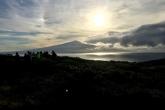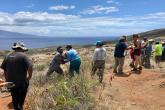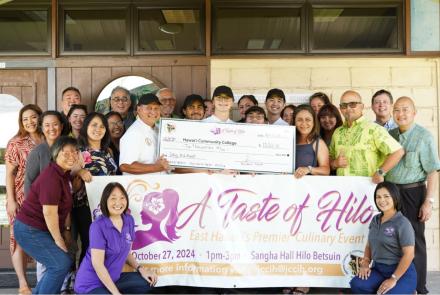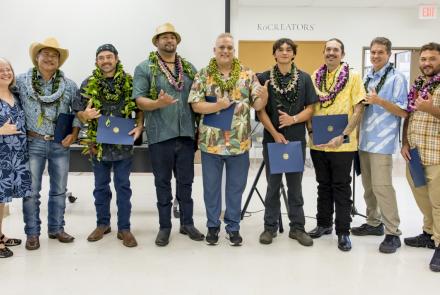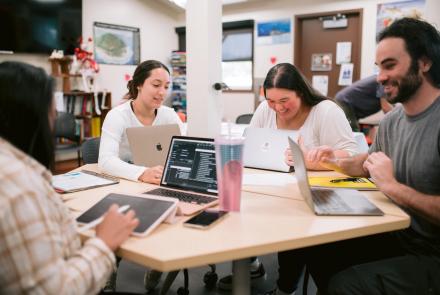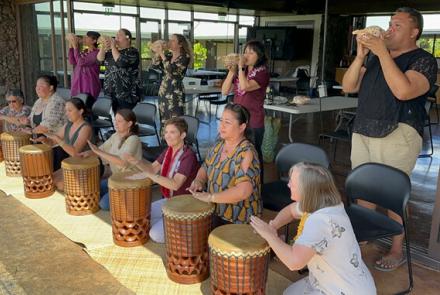Huaka'i to Kahoʻolawe Gives Students Rich Experience
By Drew Kapp, Hawai'i CC Geography Instructor – In August 2019 a hui, a group, of our current and former students traveled to the island of Kahoʻolawe and were hosted by Protect Kahoʻolawe ʻOhana. Months earlier Environmental Science/Botany lecturer Allie Atkins and I had begun the process of orienting the students to the experience, and we met several times over the summer, to prepare for the journey, bond as a hui, review protocols, share research about Kahoʻolawe, and engage in deep discussions around aloha ʻāina. The students chose to give themselves the name Kahoʻiwai, a name that references the return of water and of life, and recognized the weight of that name and the kuleana, the responsibility and privilege, associated with it.
Once the departure date arrived, the hui traveled to Maui to overnight, and then went by a small fishing boat to Kahoʻolawe at dawn, swimming ashore at Hakioawa. The hui spent three days on Kahoʻolawe, also known as Kanaloa and Kohemālamalama. There they camped; greeted the sun each morning; learned about the wahi pana, the legendary and sacred places, of the island; engaged in kilo, keen observation; were visited by numerous ‘iwa, the great birds that soared along the island’s coasts; dyed kīhei in the blood red soil of the island; helped with meals; taught members of a hui from Waimānalo the chant and hei Mele Koʻi Honua; and participated in nighly kanikapila and talk story sessions. Our students hiked to the highest points of Kahoʻolawe, Moaʻulanui and Moaʻulaiki, to participate in a rain ceremony, and offer mele and hula and hei. Each student had brought with them a small amount of pure water collected from their respective ahupuaʻa or home places on Hawaiʻi Island, and this is what was offered at the ahu, the shrine, at Moaʻulanui, as the area was enshrouded by swirling mists that elicited joy on everyoneʻs part.
While on the huakaʻi, the journey, our students learned about the cultural significance of Kahoʻolawe, about the islandʻs ecology and special plant life, about the human history, including the sacrifices that had been made by the lāhui, the people, to recapture and restore the island after decades of bombardment by the US Navy. They participated in the ongoing work on the Ala Loa, the trail encircling the island upon which a renowned Makahiki procession takes place each year. They contributed to the life of this island who, in chants manifests as a fledgling, a sea mammal, afterbirth of a sacred union, a deep subconscious oceanic entity, and much more.
The night before our students departed Kahoʻolawe, they were gifted by PKO with wai, rainwater, collected from the Nāulu cloud that sometimes forms above the island, an elongated rain cloud traditionally stretching from the slopes of Haleakalā on Maui to the piko, the summit, of Kahoʻolawe, a cloud that can form a complete, enclosed lei bringing the summits of Haleakalā, Kahoʻolawe, Lānaʻi, Molokaʻi, and Mauna Kahālāwai on West Maui together. That lei is the image that Kahoʻiwai retains. This wai from Kahoʻolawe was brought back to the Island of Hawaiʻi by our students and presented by them to the kūpuna on Mauna a Wākea as formal hoʻokupu, an offering, for conveyance to the summit, in an act of reciprocity, an exchange of the waters of life. Our students of Kahoʻiwai have promised to continue to steward the land, embody aloha ʻāina, and contribute the water of life to those places in these Islands that need it, on into the future, together and as individual members of our community.
Our participating students included Kaiʻanui Andaya, Lihiwai Kaneko, Kaoru Sakurai, Isaac Cabarloc, Mika Gallardo, Kuʻulei Perreira-Keawekane, Kamalani Fukumitsu, as well as alumni Hulali Pai, Leilani DeMello, Bruce Torres Fischer, Uʻilani Nāipo, Shari Jumalon, and UH-Hilo Geography majors Kaylyn Ells-Hoʻokano, Tazman Shim, Alliya Gabriel, Chris Chow, and Heritage Management MA student Kekoʻolani Brown – and I extend a profound mahalo to each of them.



